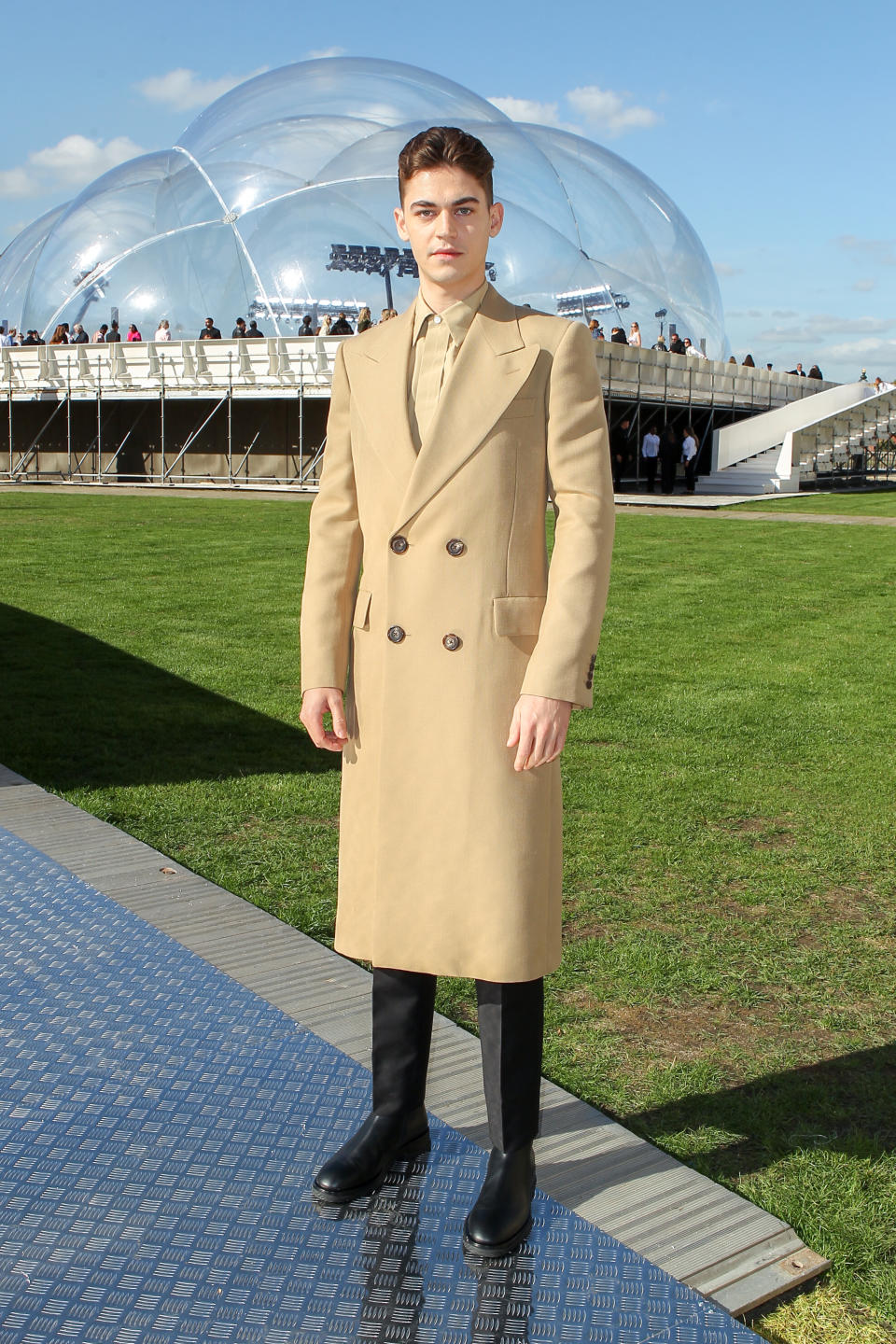Michael Miller, Founder of Celebrity Stylists Union, Has Had Enough

LONDON — Michael Miller is a stylist and a founder of the new Celebrity Stylists Union, part of Bectu, the Broadcasting, Entertainment, Communications and Theatre Union.
He and fellow freelance celebrity stylists are looking to create a framework for an unregulated industry where the studios and streaming giants set the terms. Among the many things they’d like to see are higher fees depending on experience; separate expense budgets; improved working conditions, and the ability to negotiate terms with the studios.
More from WWD
AllSaints, John Varvatos Post Strong Revenue, Profit Growth in Fiscal 2023
After a Blockbuster Christmas Takeover, Dior Opens Summer Pop-ups at Harrods
The studios’ standard fee per look is $500, all-in, including transport, shipping, tailoring, and assistants’ fees, which means that many stylists often end up working for less than minimum wage. The stylists also want the studios to understand the importance of their work and the role of fashion and style in promoting actors on the red carpet and during junkets and other marketing events.
The situation has gone from bad to worse following the SAG-AFTRA strike, claims Miller. “We have lost all work for the foreseeable future. There is nothing to protect us whatsoever. It’s terrifying” he said.
Here, Miller talks about the stylists’ concerns, and the union’s strategy going forward:
WWD: Why did you form the union with Bectu?
Michael Miller: I think stylists are universally undervalued. Fashion is an incredibly powerful medium. In terms of motion pictures you only have to look at the success of the “Barbie” marketing campaign to understand how important fashion can be as a marketing tool.
Stylists are an important part of helping a talent/celebrity form a public persona, and we rely on red carpet/promo work to keep ourselves afloat. But there are so many expectations that are simply unachievable with the resources we are given and the job is getting more difficult to do. If things continue in the way they are I fear it will become impossible.
Bectu has more than 40,000 members in many union branches of film, TV, theater and live events. This is the only way we can move forward and fight for fair pay and treatment. It’s not going to be a quick fix, but at least we have made a start.
Trying to bring together a large group of stylists who are nervous about rocking the boat and potentially losing work is not easy. However, we have had a really great response from other stylists so far. Even to have some sense of community between us has been vital to morale. To know that others are going through the same difficulties you’re facing and to be able to talk about it has really has helped so many of us.
WWD: A big part of your manifesto deals with the time it takes to put looks together, something the studios don’t necessarily understand.
M.M.: Regardless of the type of client or number of outfits needed, the styling process takes a lot of time, and a professional celebrity stylist needs a wealth of experience and a huge book of contacts to get the job done. We consult with the client to find out what they want, and we also talk to the studio/streamer/publicist as to what dress code they have set for the event.
For new clients we will provide mood boards with suggestions of outfit ideas that would work for their needs. We then start the process of calling in clothes by contacting multiple brands to find out what they have available. We need minimum four days to do this to allow brands to look into availabilities, and there is a lot of negotiation. You are not always guaranteed clothes, so you have to cast your net far and send requests to many brands. Often, we are contacted last minute and expected to work miracles with precious little time, or no time at all.

WWD: Are the fittings time-consuming?
M.M.: On a fitting day you will try on as much a possible with a client, working with a tailor to make reversible alterations to clothes. After the event all clothes need to be returned to their respective brands. We need to recall the clothes back from the client (which can take a long time), check everything is there, reverse alterations, package and return items. All in all, this process takes a minimum of a week for at least one outfit. A long press tour can take weeks, and sometimes months, to organize.
This is all on the proviso that your client is someone whom the brands want to dress. If your client does not have much of a public profile or does not fit the sample size provided by brands it becomes more complicated. For non-sample sized clients, we have to work with shop stock which, when worn, is often unsaleable. So a client needs to be deemed worthwhile to dress by a brand. More and more brands are beginning to [feel that lending clothes] is not worth the effort, making it harder to dress clients who are not sample size. Also, we are not given the money by studios/streamers to buy clothes.
WWD: What do the studios pay the stylists?
M.M:. The pay is pretty dire. For red carpet/personal appearance jobs we are paid an all-inclusive rate of $500 per outfit. My agent does always try to push the fee up, but it’s not always possible. Netflix set the precedent a number of years ago and the rate has barely changed despite so many streamers raising their subscription rates, adding ad-supported tiers and the cost of living rising. There are times when the rate is higher, and you might get lucky and get $1,000 a look, but those times are few and far between. The all-in rates don’t take into account the amount of time we work to acquire the clothes or the many expenses we incur.
WWD: What sort of expenses are involved?
M.M.: The stylist is expected to cover all expenses out of this flat rate. Agents, if we have them, take 20 percent of our earnings. General expenses like couriers take up a minimum 30 percent of the fee, assistants average about 150 pounds a day. Often we need tailors for alterations at a cost of around 300 pounds plus VAT [value added tax] per day. If a client wants us to fit at their home, we have to cover taxis.
European shipping has gone up drastically post-Brexit and it now costs around 40 pounds each way to ship clothes across the border. We also have to use couriers to collect and return clothing within our home city. We may have a client who wants to leave a suitcase overseas, and the stylist has to cover the cost (often hundreds of pounds) to have it sent back. It also involves complicated customs paperwork. You can lose a case full of clothes to customs for months if a client does not label the contents correctly.
It works out better when you have a press tour with multiple outfits, but they are no longer commonplace, and you can often find yourself out of pocket if you are only asked to provide one outfit. The current London living wage is 11.95 pounds per hour. After all the hours we put in, and our expenses, we are usually on less than minimum wage.
On the rare occasion we are given a shopping budget we are expected to front the money ourselves and then we’ll be reimbursed when our invoice is paid. I did a job last July with a shopping budget of 6,750 pounds which I was expected to pay myself. I don’t know any individual who has that amount just sitting in a bank account for work. And that was only the “final spend” amount. As a stylist you need options, so you may have to spend triple the budget and return the items you don’t need after a fitting. You risk going into debt if companies do not pay on time.
WWD: What does this mean for your bank account?
M.M.: Many of us have cash flow problems due to late payments. While payment terms in the U.K. are usually 30 days from receipt of invoice, few companies stick to it, and there are no laws to enforce it. There are numerous bad payers out there, and we are constantly having to juggle money. It is extremely stressful. Recouping the money needed to cover these expenses can take months.
I’ve reached out and spoken to many stylists in the past months, many of whom have said they are looking for other avenues of income because they simply can’t survive anymore on the money. These are industry veterans whom I have looked up to for years. To hear them talk about giving up everything they love is heartbreaking. I’ve often thought about throwing in the towel, but I have come so far, how could I give it all up now?
If the rates don’t increase and our costs aren’t covered many of us will have to give it all up. I have no idea what else I would do if I couldn’t do this. I have built my job from the ground up; I am so proud of what I have done and I will fight to keep it.

WWD: What will it take to change the system?
M.M.: Talking. We need regulation. We need contracts. And we need to be in our clients’ contracts as well. We need service agreements and a minimum base rate that studios/streamers can’t [undercut]. We need stylists and agents to agree not to undercut each other. Artist agents need to talk with each other and decide, as a unit, what they will and won’t accept in terms of stylists’ fees. Right now it’s the Wild West.
We need to be talking with our clients’ teams and talking with the companies who are paying us, to explain our working processes, time scales and costs. We need to be paid not only for the number of outfits needed, but for the time we put in, too, and to be paid in a timely manner. Our fee is our fee, and we need to be paid expenses on top.
I would like it to be the industry standard for contracts, terms and conditions to be signed by our employers, clients and their teams. Currently there is nothing, and we can end up in very precarious situations. We have also been creating a guidance document that breaks down our working processes, time scales, costs and services. It will also detail what the client needs to deliver in return for the stylist providing clothes, such as high-quality imagery, social media posts, and returning clothes in a timely manner and in the same condition they were sent in.
Fashion needs to be taken more seriously. For too long we have been seen as frivolous and superficial. Fashion is powerful, transformative, necessary. With ad-supported content being pushed more and more I think it’s vital that studios and streamers take us seriously and work with brands and stylists to create exclusive fashion-related content for their platforms.
If studios/streamers were to hire their own photographers for red carpets and press junkets/promo it would help massively. Fans are incredibly interested in celebrity fashion, and it would only benefit a studio’s marketing efforts if they were to work with stylists and brands in placing imagery with various press outlets. Giving publicity to brands is vital to keep relationships strong, and social media posts and press features are the bedrock of this.
WWD: Do fashion brands have a role to play in this conversation? If so, what should they be doing?
M.M.: Fashion brands could certainly help to educate studios/streamers on the complexity of our jobs. One idea is to clamp down on what [stylist fees] they will and won’t loan for, and have more defined criteria for stylists and studios to fulfill before loaning clothes. This will give stylists something more concrete to give to studios/publicists so they know they have to provide and promote the imagery properly. Paying stylists for branded events such as parties and fashion shows helps massively and can help [us] top up bad rates from studios/streamers. After all, it is the stylists who cultivate the relationships between clients and brands.
WWD: Do the actors also have a role to play?
M.M.: They are incredibly powerful. If the entire cast of a movie or TV show clubbed together with their styling/hair/makeup teams and refused to do press unless everyone on their team was compensated and treated fairly, then the production would have no choice but to listen. Look at what has been happening with [the American actors’ union] SAG-AFTRA and the power of their strike. Studios often bend over backwards to keep clients happy during promo, yet the same treatment is not extended to the teams that are behind them. On sets or junkets I have often felt unwelcome by studios/streamers.
I have immensely strong relationships with my clients that go way beyond my role as a stylist. I [act as] a parent, psychologist and cheerleader. When I am there they feel safe, much like they feel safe with their own publicist, hair and makeup people. I think we deserve to be taken into consideration when negotiations and contracts are discussed. If we are written into contracts then there is nothing that anyone can do about it. If clients with clout were to say, “I am not doing this without my stylist and my entire press team, and you will pay them,” we would have to be taken more seriously.
Best of WWD

